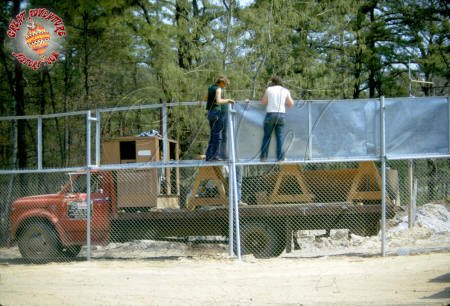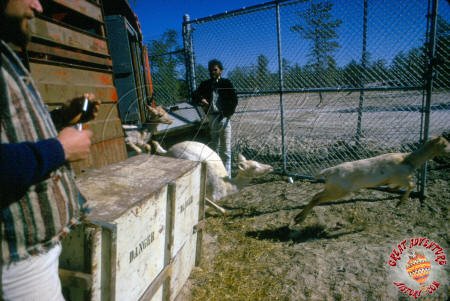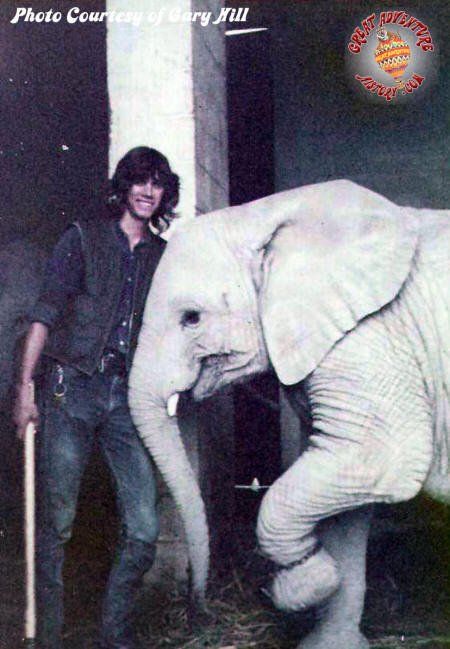|
As the 1960's drew to a close and the 1970's began, the baby boom
generation grew up and started looking at things in different ways than
past generations. They had begun
to question everything in the world around them including man's impact
on nature. Environmental
awareness came to the forefront with an awareness of the mistakes of the
past and their impact on the land, water, plants and animals. Pollution
and the decline of cities combined with the increased mobility of the
automobile culture and subsequent creation of the Interstate Highway
system gave rise to theme parks. Just as theme parks were an evolution
from the dirty, old traditional amusement parks, zoos would also
transition during this time
going from concrete and steel cages to more natural habitats as people
began to realize that the animals deserved better treatment and more
natural and realistic habitats.
Taking the zoo concept and
turning it on its head, drive through safari parks allowed the animals
to run free while the humans were in the cages. The animals would be
free to roam larger areas than they ever could in zoos, and habitats
more closely resembling their native homes could be created.
Several companies jumped into the drive through safari business
following a formula of animals with similar geographic origins
cohabitating in fenced in areas separated by gates.
This allowed cars to flow along winding roads while animals
interacted with each other as well as with the passing vehicles.
Throughout the U.S. and other
countries these safari parks opened with varying degrees of success.
Some, like the Lion Country Safari parks were opened as part of theme
parks. The marriage of the safari concept and the theme park concept
proved to be a winning combination.
|
 |
|
|
|
Map of World of Animals
 
Like Great Adventure's Safari, the meandering
roads took motorists through various habitat areas.
Some of the
animals from World of Animals were brought to Great Adventure.
|
|
|
|
 |
The elected officials of Jackson
Township and Ocean County were looking to bring in new economic
development in the early 1970's and looked to the success of safari
parks as a potential tourist attraction for the largely rural area on
the western edge of the township and county. In West Milford New Jersey
the Jungle Habitat safari park which had been developed by Warner
Brothers was proving to be a success, drawing thousands of tourists to
the small town and boosting the local economy and Jackson Township and
Ocean County officials wanted to tap the same tourist market with the
ideal location midway between New York City and Philadelphia with easy
access via the Interstate Highways.
Stanley Switlik was one of the
wealthiest businessmen in Jackson Township, and owned more than 2000
acres of beautiful unspoiled woodlands with a series of manmade lakes.
Switlik had made his fortune supplying parachutes to the military during
World War II and lived in a large house near the center of the tract of
land. Working with local officials to help spur development of the area,
he offered to sell more than 1000 acres of land for the construction of
a safari park. Initially speculation was that Warner Brothers were
interested in building a second Jungle Habitat on the site, but another
developer had a bigger vision.
Warner LeRoy never did anything
by half having grown up as part of Hollywood royalty. He believed
anything was possible and wanted to create something spectacular.
He joined with the Hardwicke Group, developers of other Safari
parks in the U.K. and Canada, though nothing on the scale of what Warner
LeRoy had in mind for Great Adventure.
|
|
Warner LeRoy in partnership with
Hardwicke entered into an agreement with Stanley Switlik to purchase the
land to build Great Adventure. After the agreement had been made, plans
were drawn up for "Maxwell's Adventure", building on the success of
LeRoy's "Maxwell's Plum", which had become one of the hot dining spots
in New York City. As the plans
for the park were revealed, Stanley Switlik balked at completing the
land sale, claiming he had committed to the sale only for construction
of a safari park and took legal action to block construction of the
theme park. Legal wrangling delayed construction until finally the
courts found for Great Adventure and the construction of the park began
behind schedule.
|
 |
 |
 |
| |
|
|
Before any construction began on
the Safari, detailed topographic studies of the property were conducted,
mapping the natural hills and features of the terrain. Animal habitat
experts were brought in to study the property and determine how to best
use the land to create the most natural habitats for the animals as well
as preserve the natural beauty of the land.
Preserving the trees on the site was one of Warner LeRoy's main
focuses, and before any
clearing was done careful planning was done to remove the fewest trees
possible during construction.
Several areas were cleared to
create grassy plains for the grass eating animals, and small ponds were
created in several locations to create watering holes for the animals to
drink and bathe. The 6 miles
of 3-lane road were cleared and paved and a the barn facilities to house
the animals were constructed in the center of the Safari along with
veterinary facilities and other support buildings along the northeastern
edge.
|
 |
| |
|
 |
 |
| |
|
 |

Each section also featured small
shelters for the animals along with feeding bins of different shapes and
sizes as well as other habitat elements.
The shelters were almost all identical, with a simple steel frame
supporting a pitched roof. The
removed trees supplied the log siding for the various structures.
Feeding bins were tailored to the
needs of the animals with varying heights and sizes to match the
animals in each section. Other elements added included rocks and
boulders which were trucked in from quarries in Pennsylvania and
northern New Jersey, logs and other "play" structures for the big cats
and concrete pipe sections that were set into the hillsides to serve as
dens for the bears.
The entire Safari was surrounded
with strong chain link fences. In many areas the fences extended below
ground to prevent animals from digging under and with the really
dangerous animals like the big cats and bears, metal panels were
attached to the tops of the high fences, preventing the animals from
climbing over the top. The
metal panels were painted green to help make them blend in with the
thick forest behind them and make them less obtrusive.
|
|
|
 |
|
|
 |
 |
| |
|
| |
|
 |
 |
| |
|
 |
 |
| |
|
 |
 |
| |
|
To control the flow
of cars and keep the dangerous animals like the big cats and the bears
contained, a set of lock style gates were constructed at the ends of the
section. To control the gates a pair of octagonal gatehouses on stilts
were built, offering the attendant a clear view of the entire lock
section to ensure that the animals were not hiding between the cars. A
group of cars would be let into the lock and the gate closed behind
them, then the gate at the forward end would open when the area was
clear. The four gates were electrically powered, unlike the gates
between the other animal sections which relied on a human attendant to
shoo the animals back into their own sections.
|
 |
 |
Construction of the park was a
massive effort with thousands of workers all over the property working
long days and nights to get everything ready for the July opening.
Originally the opening date was slated for June of 1974 but with the
construction holdups caused by the legal battles over the theme park the
bulk of the work did not begin until January of 1974. The completion of
the park in six months was a herculean effort. |
| |
|
 |
 |
| |
|

 |
 |
 |
The plains of the Safari were
covered with top soil to support growing grass in the sandy native
earth. Since feeders were constructed for the grazing animals, the grass
was primarily intended to be decorative, but the animals' instincts to
graze meant that the grass would often be stripped leaving the plains as
a more desert-like environment.
Once the facilities were in
place, the animals began to arrive to get acclimated to their new homes. |
| |
|
 |
 |
| |
|
 |
 |
| |
|
 |
 |
| |
|
| Some of the Safari's animals came
from existing safari parks, farms and zoos. Most of the herd animals
were relocated from parks in Canada and were used to the cold climate
and though still wild, were used to varying degrees of interaction with
humans. They tended to adapt easily to the new park and the acres of
land they were free to roam. |
 |
| |
|
 |
 |
| |
|
 |
 |
| |
|
 |
The herd animals like the
gazelles and ibex here relatively easy to handle and move into the
Safari, and the staff could simply open the gates of the animal carrier
trailers. The big cats, bears and other dangerous animals required
special handling in reinforced crates. The crates could be placed at
doors built into the back of the animal shelters and using a remote
cable the doors could be opened with the handlers a safe distance away. |

 |
 |
 |
Once a crate was placed at the
door to the shelter the end of the crate would be opened as the
counterweight was pulled to raise the metal door. The animals could then
wander into their new enclosure and the door would close behind them. |
| |
|
 |
 |
| |
|
 |
 |
| |
|

The transporting animals to the Safari created
unique challenges. With the height, weight and danger involved the
transport vehicles were unique and often were a spectacle as they drove
to the park. Many of the animals were accustomed to interacting with
people





 |




The Safari's elephant herd was
brought to the park directly from Africa. An expedition was sent to
Africa with the goal of finding and capturing a herd and then
transporting the animals across the ocean to New Jersey.
Once
the animals had been rounded up and loaded into containers, they were
loaded onto planes flying from Africa to a stop over in Europe, then
onward to Kennedy Airport in New York where they were loaded onto trucks
for the final leg of their long journey.
Once at the park, the
herd quickly adapted to their new surroundings and their human keepers.
Those original elephants still live at the park today, along with their
offspring that have been born and raised at the park over more than 35
years.

 |
| |
|
 |
 |
| |
|
 |
 |
| |
|
 |
One of the most familiar aspects
fo the Safari has always been the ubiquitous striped vehicles used by
the wardens. As the animals became more familiar with their new homes
they quickly began to recognize the zebra striped vehicles since they
usually appeared with their food. |
| |
|
 |
 |
| |
|
|
At the entrance to the Safari the gate structure took shape. Four
two-sided ticket booths were constructed to handle up to eight lanes of
traffic. The booths were connected with a truss framed roof structure
providing protection from the weather. |
 |
|
|
|
 |
 |
|
|
|
| Along with the construction of
the entrance plaza and associated facilities, final preparations for
opening day included running the wiring for the FM transmitters down the
center of the road to provide the narration for each section. Once the
wires were laid, the three lanes of pavement were added. |
 |
 |
 |
| |
|
 |
 |
|
|
|
 |
When July 1st rolled around, the Safari opened to the public and was as
big an attraction as the Enchanted Forest theme park. Film crews often
toured the Safari, showing off the world's largest drive through safari
park. Guests lined up to take the 6-mile drive, and with many cars
overheating in the heat of the day, requiring the Safari's wardens to
provide assiatnce to the stranded motorists.
 |
| |
|
 |
 |
| |
|

|
| |
|
 |
 |
 |
 |
 |
 |
| |
|
 |
 |
| |
|
 |
 |
| |
|
 |
 |
| |
|


 |



 |
| |
|
 |
 |
| |
|
![]()

![]()


